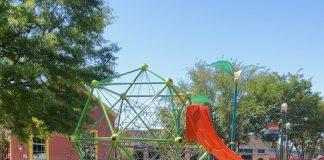Disclosure :: This post was written by Aimee Cotter, Director of Advancement and sponsored by Academy of the Sacred Heart and Berchmans Academy.
5 Things to Consider When Evaluating School Options in a COVID-19 World
Now that we’ve reached the finish line of the “distance learning marathon” and have all enthusiastically, and quite deservingly, high-fived and toasted each other for sprinting — and at times limping — to the end, I think that it’s safe to say that we’re all staring at fall with more questions than answers at this point.
The transition to distance learning was swift and fierce, like a stomach virus…that lingered…for two months. And just like a stomach virus, we cleaned up a lot of messes, wiped a lot of tears, and we have vowed to sing happy birthday while washing our hands for the rest of our lives.
But how do we feel comfortable with returning to school? What if it happens again? Distance learning offered some wonderful opportunities for bonding and creativity at home, but it also left many with questions about how schools will move forward in this new normal.
As we look towards the future of education for our kids, here are five things to consider when evaluating your school choices in a COVID-19 world:
1. How will the school strike a balance between the academic, social, physical, spiritual, and emotional needs of your child?
By now, we have all ZOOM-ed, Google Classroom-ed, Seesaw-ed, and YouTubed enough activities to teach fractions, recite the life cycle of tadpoles, and distinguish between proper and improper nouns, all while preparing dinner, jumping on a conference call, and training a puppy (a puppy seemed like such a good idea since we were all home together).
For the most part, schools have a pretty good handle on how to communicate lesson plans if remote learning must continue. But, what about the rest of your child’s wellbeing? How is the school prepared to create engaging opportunities for your child to meet up with his or her friends (either in person or virtually)? Experts relay that anxiety levels for children have been on the rise as kids are away from the comforts of their routines and their friends. How is the school prepared to ease those anxieties and help the kids develop necessary life coping skills?
2. How is technology integrated and accessed through the curriculum? How is screen time managed?
This question is twofold. Data shows that one size doesn’t fit all, and kids need a variety of learning methods to remain engaged. So how will the school structure a mix of live instruction with pre-recorded material? What learning apps and devices will be required to transition to distance learning? Will those be sent home with the kids? Can students work independently, or will parent oversight be needed (please say no, please say no)?
And then there’s that unspoken elephant in the room — screen time. Screentime is one of the great ironies of mothering during this crazy time. For years, we have read about the dangers of too much screen time and its effects on cognitive and social development. But then on March 13, all curriculum and interaction was moved to devices, and those rules were thrown out as quickly as the iPads were charged. Each Sunday, I dreaded the Update of Shame from my phone that shared how my screen time increased by x number of hours this week over last. I got it, I got it. Too much screen time. So, if history repeats itself and we have to bring school home again, how is the school prepared to balance screen time with other meaningful non-screen activities that coincide with an engaging curriculum?
3. What support does the school offer for families (especially those with two working parents)?
Distance learning with children is no joke for anyone, but distance learning with two parents working full time is like swimming a mile, upstream, against the current. With Big Foot chasing you. Working parents need HELP. We need flexible learning plans and flexible schedules. We need for schools to understand that we are doing the very best that we can to accomplish a nearly impossible task, only to have to wake up again tomorrow and start all over again. How is the school planning to partner with parents so that everyone succeeds?
4. How will teachers assess children’s knowledge base and determine where to begin in the fall?
This one is tricky. Usually, standardized tests offer a pretty clear picture of what the kids learned during the year and what may need some additional attention in the fall. But this year, we don’t have any of that data, and the experts report that the “summer gap” (the knowledge that is lost over the two months of summer break) will be significantly larger this year than in previous years due to the pandemic. So how will the school assess your child’s knowledge base and know where to pick up instruction? How will they catch everyone up — and how long will that take?
5. How prepared is the school to quickly pivot if the situation changes again?
Heaven forbid, what do we do if school closes again some time during the next school year? Has the school made plans for a quick transition? How will plans be communicated? What has the school learned from this go-round that will improve their efficacy and experiences? What does the school identify as their greatest strengths during the pandemic? Its greatest weaknesses? How are they being addressed?
With so many schools out there touting distance learning capabilities, it can be hard to cut through the clutter to find a program that’s invested in the complete development of your children. Keeping these questions in mind, you’ll be able to better evaluate the schools available and determine which option is best for your family.
 Aimee Cotter is the proud wife of her very understanding husband, Con, three energetic children, Claire (10), James (7), and William (5), and their new pandemic puppy, Belle (3 months). Her hobbies include preparing snacks, supervising teeth brushing, moderating disagreements, and refilling the hot water in her bath at least 2 times each night. When she is not busy rustling up 35 different types of snacks each day for her roommates, she also works full time as the Director of Advancement at the Academy of the Sacred Heart and Berchmans Academy.
Aimee Cotter is the proud wife of her very understanding husband, Con, three energetic children, Claire (10), James (7), and William (5), and their new pandemic puppy, Belle (3 months). Her hobbies include preparing snacks, supervising teeth brushing, moderating disagreements, and refilling the hot water in her bath at least 2 times each night. When she is not busy rustling up 35 different types of snacks each day for her roommates, she also works full time as the Director of Advancement at the Academy of the Sacred Heart and Berchmans Academy.


















